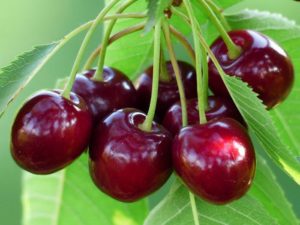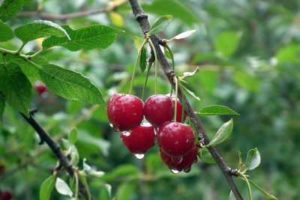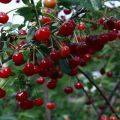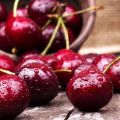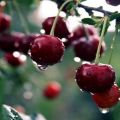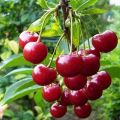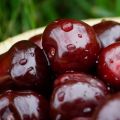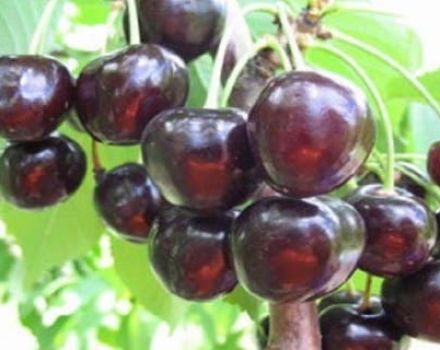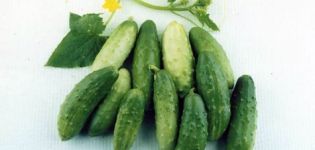Description of the Brusnitsyna cherry variety, characteristics of yield and frost resistance
Cherry is a tasty and healthy fruit that is grown in every garden. There are a huge number of cherry varieties - registered and unregistered. One of the unregistered, distinguished by its qualities and unpretentiousness, is the Brusnitsyn cherry variety.
Description of the variety
Cherry Brusnitsyna - lignified low bushes with widely spreading branches, a large number of fruits. Belongs to the Pink family, genus Plum, subgenus Ordinary cherry. From the Latin language "Cerasus - cherry", the name comes from the city of Kerazund, from which cherry seedlings were first taken to Rome. The following are the characteristics of the Brusnitsyn cherry variety.
The bushes grow up to 200 cm in height, bloom profusely in the 4-5th year, after which green fruits are formed, which, when ripe, become crimson. Flowers bloom in mid - late May.
The fruits are large, round, the weight of one berry is up to 6 g. Inside the berry there is a small round pit, easily separated from the pulp. The fruit has a sweet and sour taste, the pulp is fleshy, juicy. The annual yield for an adult plant is 12-20 kg.
Last year's shoots have a lignified appearance, the bark is brown-gray, young shoots are green. The branches are flexible, well pruned with pruning shears. Leaves are glossy, bright green above, light green below. Petiolate, elliptical, up to 8 cm in length, pointed at the end. The edges of the leaves have small denticles.
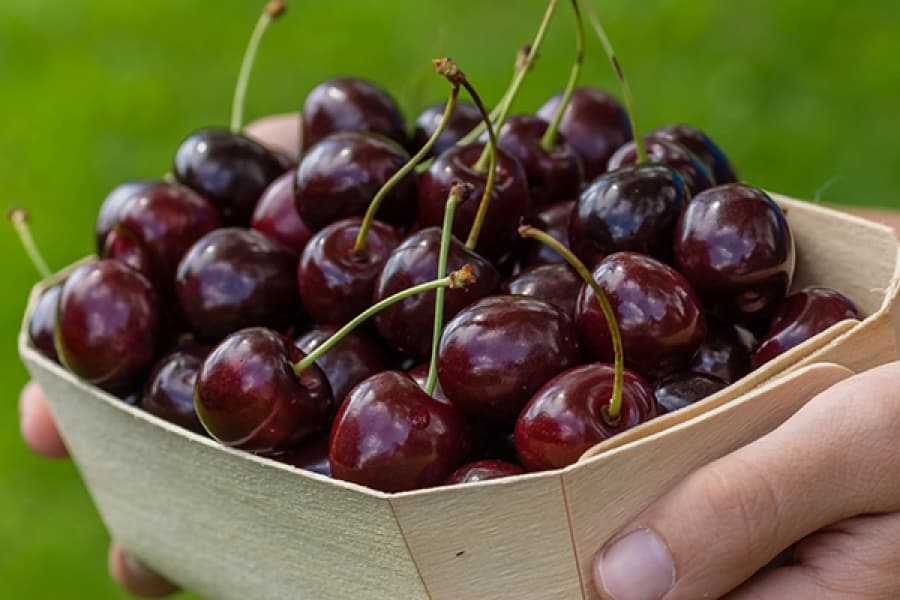
The root system is powerful, growing up to 1.5-2 m in depth and width. The variety is suitable for growing in a frost resistance zone 3-4, withstands frosts down to -40 ° C, northern regions of Russia. Cherry Brusnitsyna is an early variety, flowering lasts 2.5-3 weeks.
Advantages and disadvantages
One of the main advantages of the Brusnitsyn cherry variety is its simplicity in cultivation:
- The variety is resistant to severe frosts and temperature extremes. Withstands up to -40 ° C.
- The fruits ripen quickly, the yield is high.
- Resistant to disease.
- Unpretentious to the place of cultivation and soil.
- Affordable and comfortable harvest height.
- Self-fertility. The ability of flowers to be pollinated with their own pollen, which is a particularly valuable advantage in growing conditions in northern regions with unstable weather conditions.
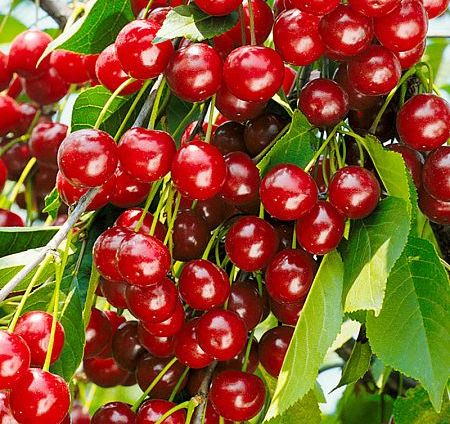
The main disadvantage of the described Brusnitsyn cherry variety is that it requires a careful choice of a place, closed from strong gusts of wind and drafts. The cultivar requires formative pruning annually. For more pollination of flowers, you can plant the Mayak cherry variety nearby, which will increase the yield by 10-20%.
Features of planting and care
If all agrotechnical conditions for growing Brusnitsyn cherries are observed, 20 kg of fruits can be removed, starting from the fourth year of growth.
Growing conditions
The soil should be sandy loam, the pH level is neutral (5.5-7). The most successful planting site is the western, southwestern side of the garden. Near a fence or building walls. They are planted from them at a distance of 2-3 m so that the bush can grow. A young plant should be planted in a sunny place or in partial shade.
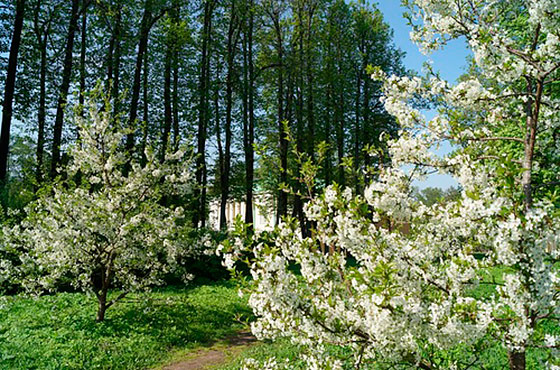
The first year of wintering should be accompanied by a warm shelter and high hilling of the seedling. It is very important that the underground waters lie deep - more than 2.5 m. Irrigation is carried out 1-2 times a week in dry weather, 20-40 liters of water around the bush. Young seedlings should be watered more often - 2-3 times a week.
Small grooves should be made around the bush to drain excess water, especially in heavy, heavy rains.
Fertilizers are applied 2-3 times per season. For the first time after the spring thaw, before budding, fertilizer with nitrogen is applied under the bush. During flowering, phosphorus-potassium fertilizer is used. Before preparing for the winter, complex or micronutrient fertilizers are applied.

Preventive spraying against pests and diseases is carried out in the spring when young leaves appear. Pruning is carried out annually in spring, frozen, damaged shoots are cut off, and the type of bush is also formed. It is very important that there are no weeds and diseased trees around the bush. The soil is loosened 1-2 times a month, depending on weather conditions.
Stages of planting in the ground
A favorable time for planting Brusnitsyn cherries is spring, April-May:
- Prepare the pit. The depth and width of the hole should be 1.5-2 times the root system of the seedling. Lay a drainage layer on the bottom to help remove excess moisture. The next layer is organic fertilizers - rotted manure, droppings, compost, peat, coniferous humus.
- Prepare the seedling. Soak in water for 3-5 hours, you can add a root stimulator.
- Pour the prepared pit with water - 1-2 buckets.
- Treat the roots of the plant in a manganese solution before planting, clean or remove damaged by pests.
- The seedling is planted in a hole and sprinkled with a mixture of soil and sand.

After planting, the seedling is not watered from above, watering is carried out after 3-4 days.
Important! If the seedling is weak, then before planting it in the hole, you should firmly hammer the support - a stick, metal fittings into the hole, and only then plant the plant. In this way, the cherry roots will not be damaged by the support.
Diseases and pests
The Brusnitsyna variety is resistant to diseases, but if the rules for feeding or pruning are not followed, the plant's protective properties decrease and diseases may occur.
They are also facilitated by wet, warm weather, prolonged rains, lack of harvesting of fallen leaves:
- Coccomycosis is a fungal disease that manifests itself in the form of small brown spots, gradually growing and merging into one spot on the leaf. Then the spots dry up and fall off, leaving holes in the sheets.
- Moniliosis (fruit rot) - a fungal disease affects the fruits of the plant, white spores appear on them. The site of the lesion becomes brown, after which the cherry falls or can mummify and hang until frost.
Most often, such pests are found on cherries:
- Cherry fly.
- Cherry weevil.
- Sawfly.
- Aphid.
In order for the plant to have persistent immunity against pests, it should be sprayed with preventive drugs. Cherry Brusnitsyna is a variety that is suitable for canning, drying, freezing without large losses of nutrients and taste. An important rule for growing this variety is compliance with agrotechnical conditions and preventive measures.
